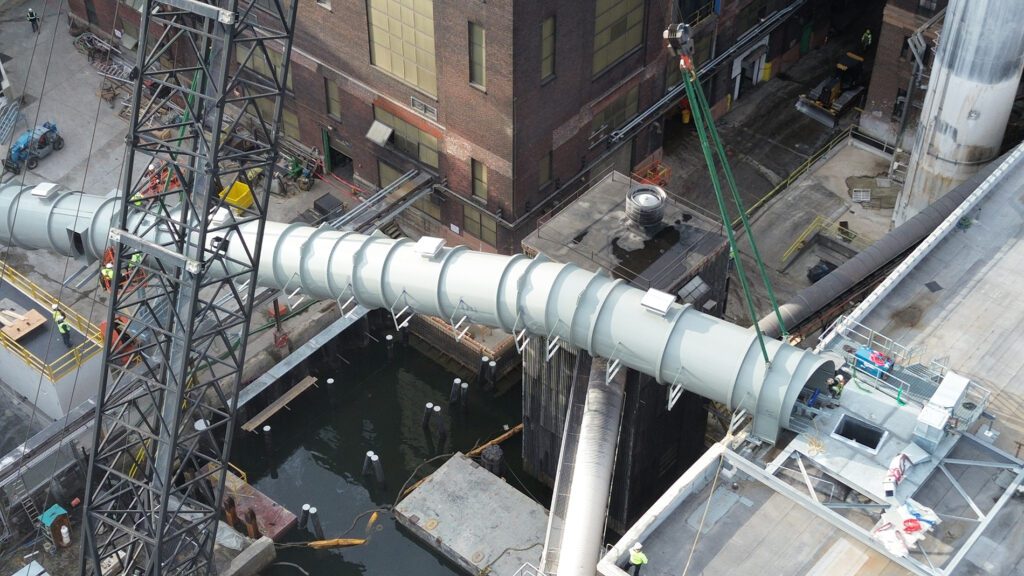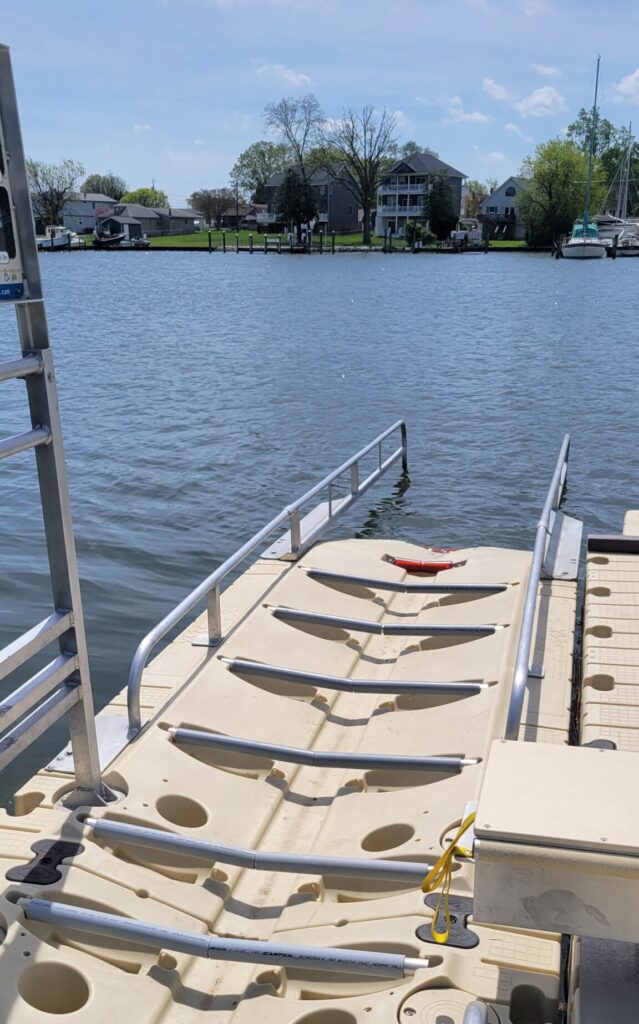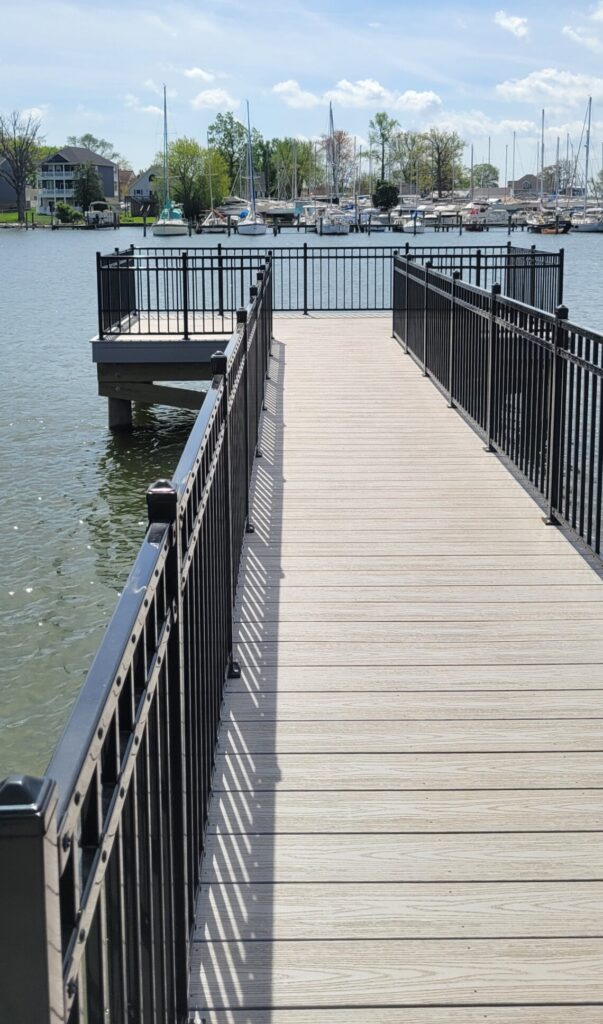Museum projects merge history, technology and unique design
From rigging a two-story artifact into an existing building to contending with construction site surprises (like a nuclear fallout shelter) to mastering the finer points of museum choreography, archival environments and goth gardening, museum construction challenges project teams to devise creative solutions to unique conditions and goals.
When Design Collective developed a renovation proposal for the South Car Shop at the B&O Railroad Museum, they took a big, calculated risk. Despite its popularity and acclaim, the museum faced some challenges due to its limited visibility and access.

Breaking with the museum’s master plan, Design Collective recommended excavating a large part of the site and moving the main entrance to the lower floor of the under-utilized South Car Shop.
That concept created opportunities for several dramatic design and functional improvements.
The South Car Shop “has these giant trusses. It has beautiful volume,” said Scott Vieth, Principal. “So, very much like when you walk into Grand Central Station in New York and ascend up into an amazing volume of space, you will come into the museum and go upstairs into this grand, huge space.”
The entrance design would also fix the museum’s “choreography problem,” Vieth said. B&O’s current entrance delivers visitors directly into the museum’s Crown Jewel — the Roundhouse. Consequently, many visitors never explore other parts of the museum. The new entrance will lead visitors past other exhibits, meeting areas and the museum shop before ending at the Roundhouse.
The design also addresses a goal of the museum, namely better connection with the adjacent Pigtown neighborhood.
“The museum has always had visibility and connection issues with the neighborhood and that’s inherent to what this site used to be. As a functioning railyard, it wasn’t looking for the community to come in,” said Brian Reetz, Principal.
Site excavation, the new entrance and other renovations (including the installation of a large rooftop sign in the tradition of Domino Sugar, Montgomery Ward and Natty Boh) will make the museum more visible and create obvious pathways to the entrance and parking.
Grading changes will give the public clear view of some historic trains parked onsite that currently aren’t visible. Exterior renovations will also provide the neighborhood with free, daytime access to a new amphitheater and landscaped area around the museum’s entrance.
“Opening the site up to the community was really important,” Reetz said, both to provide a public amenity and “to show off this great museum, encourage people to spend time in the area and attract development and investment.”
Dark inspiration
At the nearby Edgar Allan Poe House and Museum in West Baltimore, designers and engineers have planned a $10 million, 15,000-square-foot renovation and addition project. In addition to creating an enhanced museum and a destination for Poe’s international following, the project is expected to become the centerpiece of the redevelopment of the Poe Homes — a historic, affordable housing development.
Creating an improved Edgar Allan Poe Museum, however, requires some unconventional thinking.
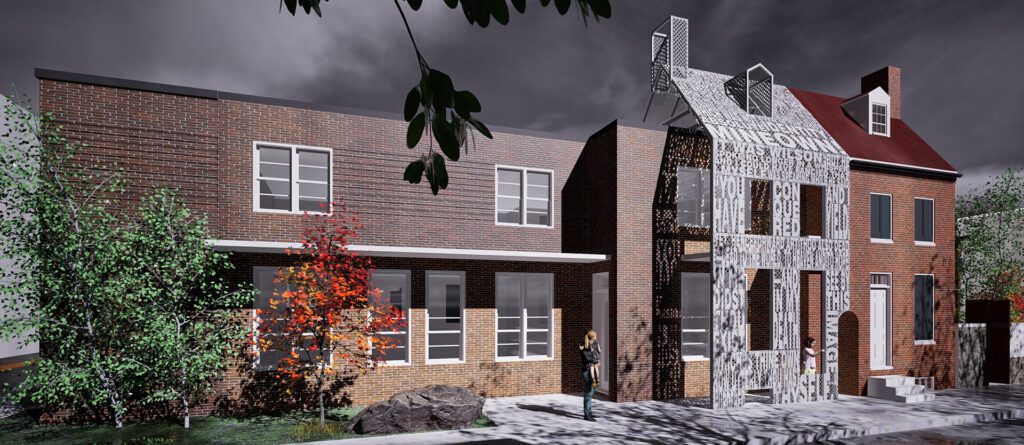
During the design phase, plans to add a second story to the museum were rejected in favor of a suggestion the museum expand underground instead.
“Poe is very goth, very dark so suddenly this idea of creating catacombs in the basement of the museum started to feel like the right thing for this project,” said Kristen Gedeon, Senior Associate with MK Consulting Engineers.
As an amenity for the museum and the neighborhood, the design includes “a beautiful outdoor garden space” but with a different style.
“There is something called goth gardening,” Gedeon said. “You use plants that have dark colors — deep reds and purples. We are really leaning into the darkness and moodiness of Poe’s work.”
Under the planned renovation, the museum will expand into four adjacent Poe Homes units for its first phase. Part of the building’s exterior will be veiled with a metal screen that includes words from Poe’s writing.
“The architects see the sculpture, the metal screen as a way to activate the street,” Gedeon added. “It will be an interesting transition from very traditional row homes to a more mid-century type of architecture in the museum.”
Incognito design
Not surprisingly, executing those unique and highly imaginative designs presents a world of challenges to construction teams.
Earlier this year, Hirsch Electric completed the electrical package for an 18-month renovation of the Jewish Museum of Maryland in the Jonestown neighborhood.

The project included the transformation of an exhibition arcade. The immersive space is lined with custom-designed display cases that combine materials from the museum’s collections with interactive technologies. The combination helps visitors engage with Jewish stories in dynamic and interactive ways.
The renovation also included construction of a new state-of-the-art audio/visual production studio and additional rotating gallery space to present exhibitions, serve as a black box theater and as multi-purpose program space.
Set in a 1990s building, the improvements “required a lot more electrical distribution to update everything and support the interactive systems. We did a lot of coordination with the cabinetry people to provide power and lighting in the display cases,” said Steve Grebe, Project Manager at Hirsch.
In addition to the challenge of finding ways to route new power through the building, crews had to complete work carefully to avoid disrupting museum staff onsite and avoid any damage to artifacts “especially when we were core drilling through floors and walls to run new conduits to new panels,” Grebe said.
Currently, Hirsch is working through the unique requirements its crews will have to meet when they start work at the B&O Railroad Museum this fall. New electrical requirements throughout the 50,000-square-foot renovation space are enormous.
“At this point, the design has over 100 conduits running from the electrical room into the building to feed everything,” said Sean Daniels, Division Manager.
“Everything” includes power to the new exhibition hall, classrooms, meeting room, archives, exhibition hall, museum shop, main entrance, exterior lighting (especially throughout the amphitheater), new rooftop HVAC equipment and a high-end lighting package that, alone, is valued at over $1 million.
“We’re learning that there is a certain look the design team wants. The best way to describe it is incognito,” Daniels said.
Wires, conduit and other infrastructure need to be hidden within concrete floors or a “floor sleeper assembly” beneath the new floor being installed on the second story. That requirement compelled Hirsch to begin extensive BIM modeling of the project to identify challenges early and coordinate installations with other subcontractors.
Daniels is also plotting out how his crews will install the sophisticated museum track lighting on the second floor. Crews will have to suspend each fixture from a trapeze structure 30 feet above the floor.
“I need to get a lift that supports that work but doesn’t have enough weight to damage the new floor,” he said. “Right now, that looks like a tow-behind aerial lift.”
Wrestling with history
For the York County History Center project, Lewis Contractors had to overcome heavy duty challenges. Built in the 19th century as an Edison Electric Light Company steam plant, the York, PA facility continued to generate electricity until the 1950s and steam until the 1970s.
“It was once a coal-fired steam and electrical generation plant, with some heavy infrastructure that was integral to the structure itself, so there was certainly something very daunting in the task of transforming this place into a next-generation history museum,” said Tyler Tate, President of Lewis Contractors.
Considerable environmental remediation had occurred before Lewis arrived onsite but the company still had to contend with some major site challenges.
“Obviously, one area that we couldn’t see was below the floors and the structural floors, originally intended for heavy loads, had varying elevations and thicknesses,” Tate said. “Borings and core drillings can only tell you so much on a site with such complicated history where multiple buildings were built and demolished, and where large installations of equipment were put in, upgraded, pulled out, and replaced.”

Site work uncovered a multitude of surprises— abandoned elevator pits, voids where substructures for old equipment had been laid and later removed, and a train track that once supported carts bringing coal into the plant.
As the construction manager at risk, Lewis also had to address the unique demands of transforming the interior of a 19th century steam plant into a modern, welcoming community history museum. One of those demands emerged from the fact that York County’s history is largely a history of manufacturing. Lewis had to deliver exhibit spaces and environmental conditions that would support both very intricate items and large, industrial products.
One of the products destined to go on display was one of the first commercial ice-making machines in the United States, an A-Frame Ammonia Compressor that was built in 1904 and was two stories high, Tate said.
“Early in the project, we created a knock-out panel that was temporarily shored, so that when the contractor was ready to move the machine inside, we could remove parts of the building without damaging the structure,” he said. We had also created a special foundation to set it on and rigged it in using specialty cranes.”
Construction market faces good, bad and unknown prospects
Between tariff wars, shifting federal legislation, speculation about interest rates, changing GDP projections, postponed projects, depressed architectural billings and ongoing strong points within the economy, the outlook for the construction industry can feel convoluted.
“Are we looking at growth or contraction in the future? What we’re witnessing and hearing from our network is about a 50-50 split between good and bad news,” said Russ Robertson, Managing Partner, Cap Ex Advisory Group.
On the bright side, the data center construction market continues to experience robust growth.
Institutional construction — higher education projects, healthcare facilities, government buildings, public infrastructure and other ventures funded by the federal CHIPS and infrastructure bills — have also continued at a healthy pace.

After five years of growth, construction spending has been shrinking in 2025. Spending in June was 2.9 percent below June 2024 levels. Spending for the first six months of 2025 is down 1 percent from the first half of 2024.
On the gloomier side, many for-profit developments in the multi-family, mixed-use, retail, office, industrial and other sectors have been deterred by sustained high interest rates and heightened lending requirements as institutions decided to lower their risk in commercial real estate ventures.
Meanwhile, uncertainty over the potential impacts of tariffs and speculation about an economic slowdown have further weighed down private developers’ calculations.
“A lot of developers who are focused on private financing, have been really struggling to make deals work, so we have seen a lot of construction deals just sit on the bench and wait for a different market,” said Ben Nichols, President and CEO of Harkins Builders.
“I definitely saw softness in the market late last year and early this year,” said Ted Bowes, President of Excell Concrete Construction and BC&E President. “Larger dollar projects haven’t been moving forward like they were in recent years.”
Those difficult market conditions mingled in with the resolution of some tariff disputes, passage of taxation laws and executive orders designed to facilitate construction are prompting market watchers to issue mixed construction projections for the near future.
“I think everyone should be cautiously optimistic but also prepare for a potential slowdown in projects,” said Matt Verderamo, Group Director at Well Built Construction Consulting.
The AIA/Deltek Architectural Billings Index has shown declining billings for almost all of the last 34 months. The one bright spot in the index is inquiries about new projects rose slightly in May and June.
“Frankly, I have been scratching my head for the last couple of months because the Architectural Bills Index seems to indicate there is going to be a major slowdown,” Verderamo said. “But there hasn’t been one. RFPs are still coming through the pipeline and there is still a relatively strong backlog for many contractors.”
While market watchers search for more clarity, construction industry experts say contractors should focus on business fundamentals.
“You always want to seek product diversity so that you can flex into whatever type of construction that’s in demand in order to keep your volumes strong,” Nichols said.
Harkins, he explained, has developed a healthy, sustainable business pipeline by developing expertise in affordable housing (a sector that remains relatively constant through economic cycles) and in institutional construction.
“We are able to work for the Department of Defense and for groups like the Johns Hopkins Applied Physics Laboratory and other large institutions that tend to weather all kinds of economic conditions,” Nichols said.
Harkins, he added, has further strengthened its pipeline by expanding into other geographic regions, including central Virginia and the Hampton Roads area, which are both currently experiencing strong construction volumes.
To weather shifting market conditions, contractors need to constantly build strong relationships with general contractors and clients and strive to become a preferred service provider, Bowes said. Subcontractors also need to be strategic in their bidding practices.
Rather than scrambling to bid on a large number of projects, “we look at the work that’s going out to bid and evaluate our chances of winning the project, getting good margins, landing work that fits what we do and for customers that are really good to work for,” he said.
Bowes and others are optimistic that more bidding opportunities are on the horizon.
“I’m actually very positive on where the economy is going,” said Bowes, who has seen an uptick in bidding opportunities recently. “If you take into account reduced margins by contractors which has occurred over the past year, and the likelihood that interest rates will go down, I feel developers and business owners will want to build something and move forward with construction in the next six to 12 months.”
The current market actually presents some favorable conditions for institutional and nonprofit construction projects, Robertson said.
“A higher interest rate environment doesn’t hurt institutions and nonprofits as much because they don’t use as much debt to finance their construction projects,” he said.
Due to legislation recently passed by Congress, “construction theoretically just got a little easier because of tax savings and depreciation advantages that would arguably make the development of institution-led or mission-driven capital projects easier, especially in disinvested neighborhoods,” Robertson said.
“In limited instances, tax-exempt institutions and nonprofits might also be able to mitigate tariffs on certain building elements by doing direct purchases from suppliers and contain their construction costs,” he added.
“I think people are more optimistic about the construction market,” Nichols said. “You’re starting to see some trade deals get done so there is a little less volatility in the market. I think banks are loosening their standards a bit, so I feel activity is going to break loose towards the tail end of this year and into 2026.”
Project Profile: Domino Raw Sugar Storage Shed

After fire destroyed the raw sugar shed at Domino Sugar in 2021, the manufacturer and its construction team dug into an extraordinarily complex rebuilding effort.
The bottom-line goal was to replace a 60,000-square-foot, 100-foot-tall shed in a tight, dockside location. The new, state-of-the-art facility would have to not only match current technologies within the sugar refinery but be capable of adjusting to future advances in the manufacturing process.
One of the first challenges was determining how to create a technologically advanced replica of the 1960s building.
“The shed was orbicular in shape, and it was a hand-built and riveted structure. As construction has evolved in the 60-plus years since the original structure was built, current steel fabrication and erection techniques prevented an exact match,” said Christopher Lamb, Senior Project Manager at WBCM Construction Services.
“To minimize the disturbance of the site, engineers had to design a concrete foundation that could sit upon the existing foundation. Close to 1,000 piles were driven to further densify and strengthen the existing soil and foundation,” Lamb said.
“Meanwhile, we worked with the pre-engineered metal building company to design a structure that would maximize the storage capacity while working within the parameters of modern construction techniques.”
WBCM also had to ensure the structure, which was more hexagonal than round, would work smoothly and efficiently with an elevated conveyor that shuttles back and forth inside the shed to deliver sugar to the refinery.
Erecting that structure along with the massive conveyors that would move sugar from ships into the shed and from the shed on to the refinery presented other challenges.
“We were building a 100-foot-tall structure and installing sections of conveyor that were up to 120,000 pounds and 300 feet long, in a single crane lift with limited access,” said Mike Baker, President of WBCM Construction Services. “So, the crane plan required a lot of care.”
WBCM opted for a dual-crane operation —positioning one crane in an alleyway and bringing in a marine crane on a barge, although the marine crane had to be limited in size due to the shallow draught in the area. Lack of space meant that crane lifts, construction sequencing and equipment assembly had to be carefully — and sometimes, unconventionally — planned.
Some shed equipment was assembled offsite, lifted with the marine crane, then barged around the harbor to the Domino site.
“There were big, long, heavy lifts around the bay to get some pieces into position,” Lamb said. “Also, crane movement was restricted on site by other buildings and structures, so we had to leave out sections of construction — parts of the roof or ribs of the structure — in order to complete lifts.”
Construction crews had to avoid interrupting production at the fully operational Domino plant during the multi-year project and sometimes change the construction plan to blend with ongoing upgrades inside the refinery.
“Domino is a living, breathing plant and, like other manufacturing plants, they are growing, changing, improving their facilities,” Lamb said.
The technologies built into the sugar shed were designed to be able to evolve with future plant operations. The facility is outfitted with leading-edge technologies to offload ships faster and optimize handling of sugars with different moisture content or other qualities.
It is also equipped with multiple, advanced fire detection and suppression technologies, including infrared cameras and automated systems that stop operations and seal off zones in the event of a fire.
Safe training center enters final weeks of construction
After a productive summer of clearing planning hurdles and completing MEP installations, crews have entered the final weeks of building the Safe Center.
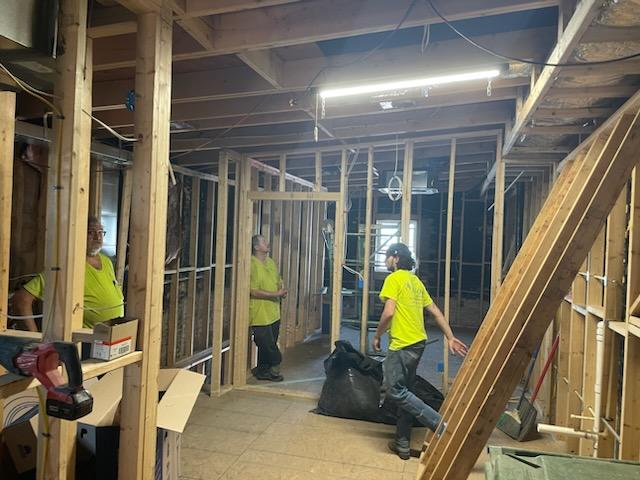
A project of the nonprofit Safe Alternative Foundation for Education, the 3,200-square-foot center on South Payson Street is designed to include a workshop and classroom space and deliver National Center for Construction Education (NCCER) accredited training programs in construction trades.
Four years ago, the BC&E Foundation got involved in the daunting plan to create the training center in three vacant Baltimore rowhouses, including one that had been converted into a car wash. The buildings had experienced decay, water damage and renovations that made the proposed project especially challenging. For example, the ground floor of the former carwash had been sloped for drainage and the upper floor raised to accommodate the car bay. The floors of the three rowhomes did not align.
Despite initial fears that the property would have to be torn down, GWWO Architects developed a plan to salvage and transform the space, and construction began.
“This project threw some pretty intense curveballs at the companies involved,” said John Stahl, former president of the BC&E Foundation and Vice President Sales at Swirnow Building Systems. “But we cleared some big hurdles in recent months and, this summer, we have really powered through the job.”
One hurdle was developing the best HVAC design for a building project that had complex needs, tight spaces and limited budget.
“The needs are a little unusual because you have a woodshop right next to an office,” said Robet Ariosa, President of Ariosa & Company. “We were trying to figure out the best system that could work within the smaller confines of the building and wouldn’t encroach too much into the working classroom space and also meet Baltimore City codes.”
That system would also have to meet the heightened ventilation needs of a workshop.
A collaboration between James Posey Associates and Ariosa & Company produced a five-zone HVAC plan to electrify the system (to avoid placing any gas-fueled equipment near a workshop) and to align with upcoming state mandates. The installation includes a VRF-heat pump system with five zones and an Energy Recovery Ventilator for fresh air, along with separate exhaust for the shop area.
Ariosa, like other companies working on the project, received a lot of support from industry suppliers who discounted their prices and even donated some equipment.
“We are blessed to have these great companies and great people involved in this project,” Stahl said.
In total, 13 BC&E member companies have committed to the project: Ariosa & Company, Baltimore Fabrication, Bunting Door and Hardware, Cap Ex Advisory Group, Excell Concrete Construction, GWWO Architects, Henry J. Knott Masonry, James Posey and Associates, Leonard A. Kraus Co., MK Consulting Engineers, Swirnow Building Systems, Temp Air Company, and The Whiting-Turner Contracting Company.
Those companies have donated professional and trade services and provided other work at low rates.
“We’re not cutting any corners with this project,” Stahl said. “The subs are providing top-quality work and materials in order to create an incredible career training center that will be a great resource for that community.”
With mechanical, electrical and plumbing work completed this summer, crews plan to spend September completing finish work inside the center. The BC&E Foundation is planning to hold a ribbon cutting and grand opening in late September.
Building a better field office
It’s dubbed the “Field Office of the Future.” And earlier this year, the innovative, comfortable triple-wide earned DAVIS Construction an Honorable Mention at the Modular Building Institute’s World of Modular 2025 awards.
Several years ago, plans to upgrade DAVIS’s headquarters convinced the company that it was also time to build a better construction trailer.
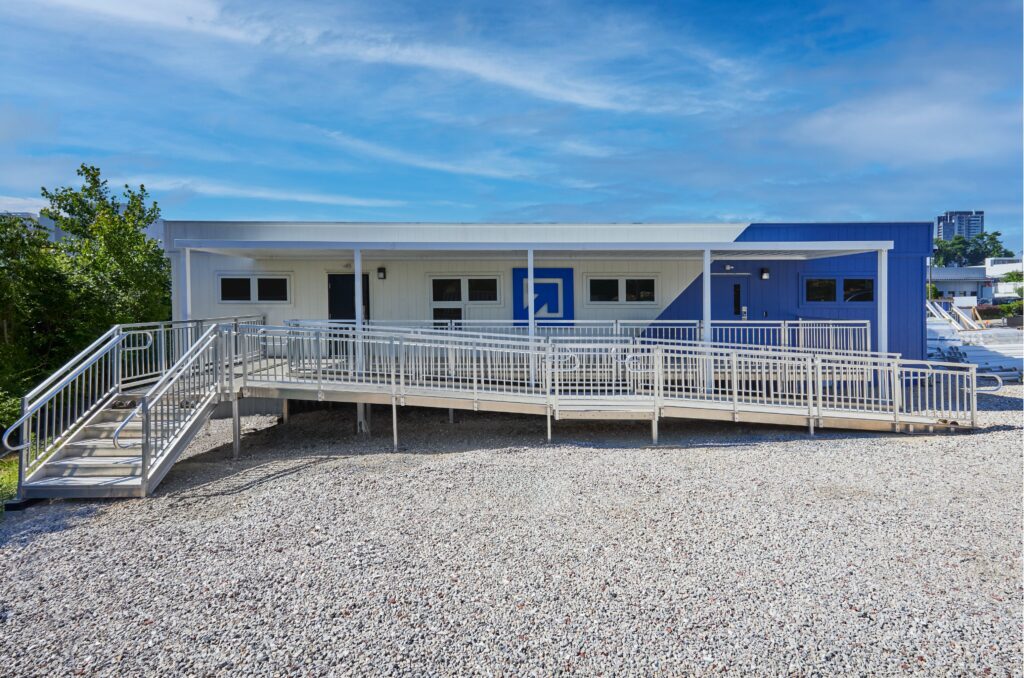
“Half of our employees are out in the field and, while we were creating better workspaces, we didn’t want to forget about them,” said Chris Scanlon, Chief Innovation Officer.
DAVIS explored design possibilities through an innovation challenge at the company’s annual conference, a design competition among summer interns and, finally, the construction of a scale prototype.
In addition to creating more comfortable, impressive and efficient workspaces, DAVIS also wanted “a fully modular, stackable, super flexible trailer,” Scanlon said. “So, if you were working in a downtown environment, you could stack the modules three high. But if you were on a site with more space, you could put the modules next to each other on the ground.”
While the prototype showed those goals were attainable, the financial estimates concluded they were not feasible. One triple-wide trailer would cost between $1.5 million and $1.7 million — nearly six times the price of a standard construction trailer.
By partnering with Maryland-based Modular Genius, DAVIS was able to refine the design, streamline the fabrication process, attain most of its goals (the revised trailer is not stackable) and cut the cost by nearly two-thirds.
Last year, DAVIS deployed its Field Office of the Future to its first site – the Parcel H high-rise, multi-family development in North Bethesda.
The benefits for staff members and visiting representatives of project partners are extensive, Scalon said.
To create a “thermally comfortable environment, we started with a high-performance envelop, two-by-six walls, well-insulated double-pane windows, high efficiency heat pumps and an energy recovery ventilator” that enables improved air circulation, he said.
“The job site is a very noisy place and it can be tough to concentrate and get your work done, so we put in a nice acoustical tile ceiling, carpet on the floors and acoustical wall panels that double as tech panels,” he said. “The improved thermal envelop also blocks a lot of noise.”
Workstations copy workstations at DAVIS’s headquarters – sit-to-stand desks with dual 27-inch monitors and docking stations.
The field office has two conference rooms with full AV systems and floor-to-ceiling white boards. One conference room doubles as a wellness room to provide a comfortable space for nursing mothers and any other wellness needs.
The design includes large windows, an ADA-accessible entrance ramp and a modular canopy “so that on days when it’s not 104 degrees, like today, you can sit outside and barbeque,” Scanlon said.
The field office has received glowing reviews from workers who have used it and, due to shifts in the economy, now costs about the same as renting a conventional trailer. DAVIS is exploring options for putting Field Offices of the Future on more of its sites.
Making a Splash
From a rooftop pool overlooking a city skyline to a community pool awash with neighborhood kids, swimming pools are some of the best loved construction projects come the height of summer.
Fortunately, a few market trends — including the desire for more amenities in multifamily developments and the commitment of some local governments to create more public recreation facilities — have been generating a string of swimming pool construction projects.

While designing The Annex on 12th, a 562-unit multifamily development in Washington, D.C, Design Collective was asked to include a luxury pool on top of the 13-story building.
As with many rooftop pools, space was at a premium. In addition, designers had to overcome a list of technical challenges involved in building on the structure; drainage, height restrictions, safety requirements and MEP systems needed to operate the pool.
“It’s an exercise in mind gymnastics to understand the technical constraints of the building while balancing the spatial needs of the project,” said Brian Reetz, Principal with Design Collective. “Big picture decisions need to be made early in the design process about the pool and unit counts, and balancing those two… In some developments, you can’t lose two apartment units beneath the pool because that won’t work with the project’s pro forma.”
A decision to retain apartments beneath the planned pool at The Annex meant designers had to alter the elevation of the roof to accommodate the full depth of the pool and the systems that needed to run beneath it. The design also had to comply with the Americans with Disabilities Act and Washington’s tight building height restrictions.

The solution to all of those challenges was to install a modest, four-foot deep, infinity edge pool at one corner of the rooftop. Set in among chaise lounges, other seating options, the building’s clubhouse, planters, a four-seasons outdoor space and a clear glass safety fence, the pool provides residents with a luxurious opportunity to take a dip, sun bathe and socialize in front of a spectacular view of the Washington Monument.
The monument, Reetz said, “is a borrowed visual amenity. It’s a very Japanese design theory. You design your space to borrow views and that makes your property more amazing.”
Other multifamily pool projects aren’t as technically challenging, but no less carefully crafted.
At The Forge apartment complex in Elkridge, Design Collective created a more spacious pool in a ground-level courtyard. The design included laminar jets along one side of the pool to create soothing white noise and a resort-style chaise lounge shelf at one end of the pool where residents could recline and drape their feet in the water.
Pools, however, are only part of the “checklist of amenities that are needed to woo potential renters,” Reetz said.
“You’re selling a lifestyle so you need interior amenities that complement exterior amenities, and the quality of amenities can make a project stand out.”

Consequently, The Forge’s pool area was designed to be visible from inside the clubhouse, but surrounded by other attractive features — a four-season outdoor space, community grills, an outdoor TV, a variety of comfortable seating options, and even space that could be used for co-working.
“I’m always surprised at how many people rent an apartment and then work in the amenity spaces,” he said.
Consequently, residents at The Forge could easily settle into a comfy chair in the courtyard or a table beneath a trellis to work on their laptops then refresh themselves midday by diving into the pool for a quick swim.
In Baltimore City, Plano-Coudon Construction is executing a different series of pool projects. As part of the city’s effort to replace aging and sometimes mothballed community pools, Plano-Coudon was contracted to build new pools at Walter P. Carter school, the Towanda and Coldstream recreation centers, and the Greater Model Aquatic Center.
The company which built the Druid Hill pool a few years ago, has been honing its knowledge of the pool-construction niche “so we can make better assessments of project scopes, conduct better upfront negotiations of contracts and be more competitive,” said Grant Cunningham, Project Executive.
That knowledge has also helped project teams navigate typical challenges.
For example, plans for The Walter P. Carter Aquatic Center called for creating a lap pool, a family pool, a bathhouse and a pump room on a half-acre site. A tight site, a tight budget and an acute need to have the pool ready to open by summer meant the project team had to avoid any time-consuming rework, even when they encountered surprises.
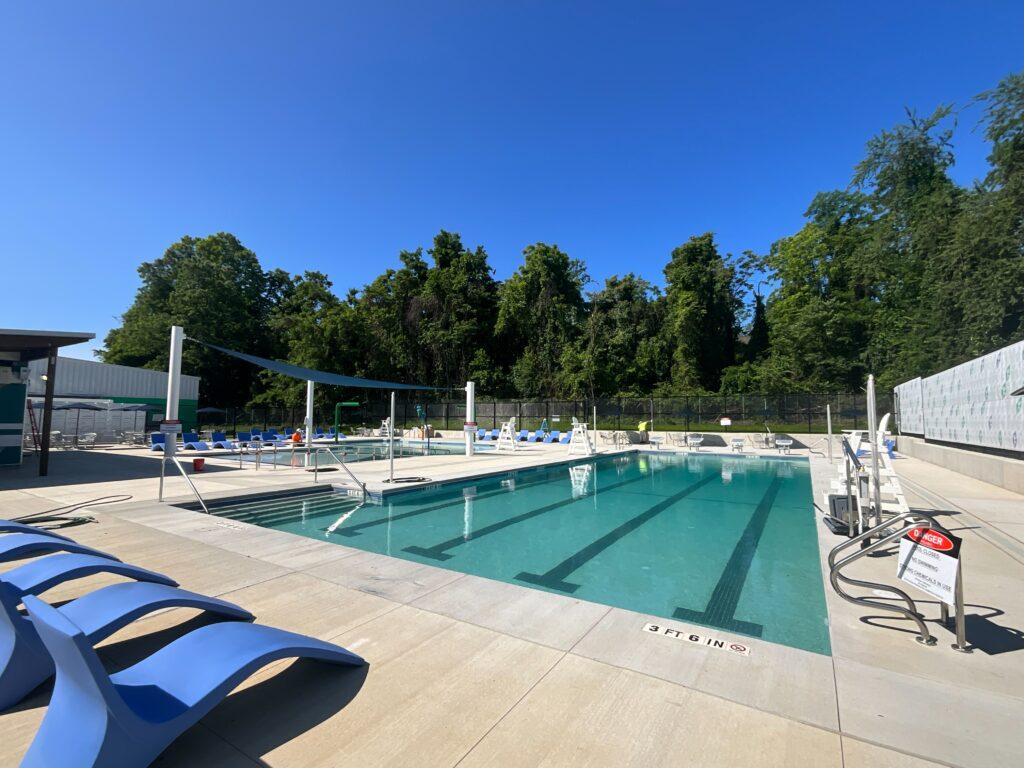
“The most impressive work that happened on this project was underground,” said Rishabh Jain, Project Manager at Plano-Coudon. “There’s so much piping and coordination that needs to happen. You have all the pool piping, supply piping and return piping for both pools looping around the site. There is also the storm drain, sanitary line and electrical lines… Knowledge of the underground utilities, sequencing all the work so you started with the deepest utility first and coordinating with all the subs was really important to making sure the installations were done right. Even a small amount of rework could have messed up our schedule.”
The project team achieved that goal, even after discovering that an existing water line that the new pools were supposed to tie into was actually defunct and carried no water.
Other city pool projects have included additional requirements.
In addition to two pools, a bathhouse and pump house, the Tawanda Aquatic Center project included construction of a new playground and an urban soils restoration project.
“It was a pretty extensive cut and replacement,” said Ben Banbury, Senior Project Manager with Plano-Coudon.
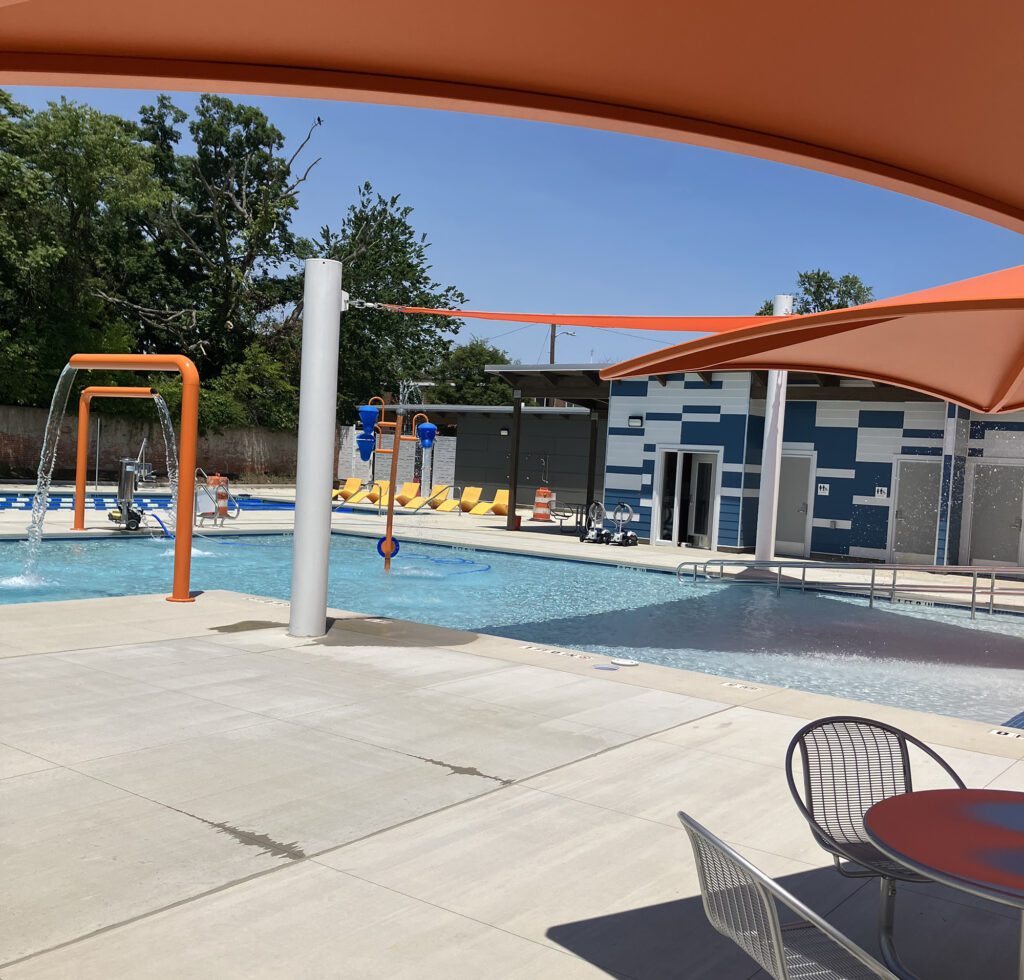
Crews had to remove two feet of soil across a former ballfield then remove rocks, unsuitable soils and other inappropriate subsurface materials, including some foundations they uncovered. Crews screened the soil, added amendments based on soil testing, layered on six inches of new topsoil, and reseeded the field.
To complete the Towanda and Coldstream projects on schedule, Plano-Coudon also had to make some bold, proactive changes to the work schedule which began last fall.
“A cold, wet winter is always a big concern when you have a project that’s dominated by site work and outdoor activities,” Banbury said. “We tried to tackle that by coordinating with the city about working overtime up front in anticipation of weather issues and getting the project out of the ground before the winter months.”
All that work on the community pool projects, however, has delivered special rewards.
The Walter P. Carter Aquatic Center is adjacent to an elementary and middle school.
“Towards the end of the project, kids were coming up to me and anyone else working there and asking, ‘Is it ready? Is it ready?’” Jain said. “You could see the excitement in their faces and how important this pool was to them.”
At the Towanda and Coldstream recreation centers, “I saw kids in swimsuits get on buses so they could go to some other pool to swim one day a week,” Banbury said. “With these projects, we are reestablishing something special in these communities that kids and families will be able to enjoy every day through the summer.”
AI becomes a construction tool
During a recent webinar by the Maryland Center for Construction Education and Innovation (MCCEI), one panelist described the importance of construction companies adopting Artificial Intelligence by quoting American futurist Stuart Brand:
“Once a new technology rolls over you, if you’re not part of the steamroller, you’re going to be part of the road.”
AI is rolling through the business world and many construction industry leaders say companies that fail to productively harness its power will find themselves struggling with a competitive disadvantage.
“If you don’t adopt an AI model to improve your back-end operational efficiency, if you don’t adopt an AI model to improve your front-end sales efficiency, know that your competitors will,” said Kevin O’Brien, CIO at Advance Business Systems. “Then, rather than having a leg up on the competition, you will be fighting to maintain your business.”
That market prospect doesn’t only apply to large construction companies. Increasingly, AI bots, personalized GPTs, data analytics, forecasting functions, and large language models are becoming business tools for mid-sized and smaller firms. And while AI adoption is a major technological advance, it is also becoming easier to implement in small to medium-sized companies.
Yael Meretyk Hanan, Co-Founder and CEO of Pelles.ai and a speaker at the MCCEI webinar, advises trades contractors to approach AI adoption with a business focus, not a technological one.
“Let’s stop and understand where your challenges are,” she said. “What are the things you are looking to improve?… Where are the inefficiencies?”
Meretyk Hanan urges companies to pick one pain point in their operations and begin their AI adoption by addressing that. Even small contractors can afford to develop custom GPTs, which can cost as little as $20 a month, to automate inefficient aspects of their pre-con or back-end operations, she said.
Many companies can leverage software systems they already license to optimize business processes through AI, O’Brien said.
“Everybody seems to have an AI copilot right now. Microsoft has one, Procore has one, Sage has one,” he said. “You don’t have to invest in expensive, new applications. You can, for example, leverage the copilot in your Microsoft 365 Suite to source data and begin optimizing your processes.”
Software companies, IT consultants and other organizations offer training on how to effectively use various copilots, ChatGPT and other AI bots.
Successful adoption hinges on several core activities, including making data accessible often through a data warehouse or data lake, securing data against hackers or inappropriate use, and directing the AI bot to focus on productive questions and use cases.
“The biggest thing to think about when you are using a GPT is your prompts. You want to be sophisticated in your prompts,” said Ricky Venters, a contractor with Hartman Executive Advisors and founder of Success Journey Strategy. “Instead of saying, ‘Hey ChatGPT, give me the answer to this problem,’ ask GPT to help you think through the right questions you need to ask in order to solve that problem.”
That approach of using an AI bot as a brainstorming partner delivers multiple benefits.
It facilitates deeper problem analysis, brings more relevant data into the process, helps prevent AI hallucinations or results based on incorrect or insufficient information, and “it does not infringe on your authority, your thought leadership and your understanding of your business,” Venters said.
“Over the next decade, firms that want to win in the construction industry will need to adopt AI to solve the problems our industry has experienced for decades – too many delays, too little coordination and too much wasted time,” he said.
DPR Construction is already using off-the-shelf products, including ChatGPT and Microsoft CoPilot, as well as some custom AI tools developed inhouse to boost its operational efficiencies.
The company’s efforts have focused on AI use cases that can deliver the greatest benefits, said Hrishi Maha, a Data and AI practice leader with DPR. To date, those have included using large language models to rapidly access information about a workflow or project, and accelerating access to information embedded in construction specifications, RFIs, and other project documents.
DPR’s AI adoption has also tackled a perennial construction challenge, namely staffing levels.
“Working with our preconstruction team and our business developers, we developed an algorithm which helps people predict what staffing will be required for a project,” Maha said. “Based on work we have completed previously, it will estimate the FTEs required and the individual traits needed. It might say you will require two project managers, two schedulers, a safety engineer and two project investigators to execute a job, and it will give a range of hours for those people.”
That prediction, Maha cautioned, isn’t foolproof. “There are so many nuances in construction which AI is not going to know about. But it gives teams a good starting point and, if the AI estimate is different from their own estimate, it will prompt people to assess the situation more deeply.”
DPR, which has been gradually integrating AI-enabled processes throughout its project and business workflows, expects the technology to fundamentally improve performance within the construction industry.
“AI is the next technology frontier… It can change how we do construction,” Maha said. “The result will be time savings for our people, accelerated jobs, better schedules, more predictable outcomes.”
Faster, safer, smarter
How could AI improve your operational efficiencies today?
Smart schedules:
Incite Automation has built AI-supported project management systems that assess tasking for construction projects. The systems know the roles and certifications of each company’s employees. Based on that knowledge and project specifications, it will propose assignments to a particular job.
“It is able to make determinations based on the location of the jobs and the employees, their certifications and past performance,” said Dustin Sitton, Principal at Incite Automation and a speaker at the MCCEI AI webinar in May.
The system, he added, can also generate proposals for the equipment that should be assigned in conjunction with those individuals and propose adding “fluff time” to a schedule, based on the project’s circumstances.
The tasking plans aren’t always 100 percent correct, but they still save construction companies a great deal of time, Sitton said. “I know organizations that use a big, Excel spreadsheet and spend a day, a week or more on resource management. Now they are getting suggestions [from the AI system], making minor tweaks and they are done in an hour or two.”
Safety:
The combination of AI technology and security cameras, drone videos and other surveillance can enhance jobsite safety while also reducing the time needed for safety compliance.
One Incite Automation client employed a “hard hat guy” to walk jobsites and ensure everyone was wearing their hats. Incite linked the jobsite’s network of security cameras to the contractor’s Power Automate program in the Microsoft Ecosystem and trained an AI bot to recognize a person without a hardhat. The system then scanned the site every 30 seconds and alerted the company to any hardhat issues.
Code compliance:
Higher models of ChatGPT are able to answer questions about building code compliance, including what is required in local, international and other codes, and the changes between different iterations of each code.
Preconstruction and back office operations:
In many companies, AI-supported systems are streamlining payroll processing, invoicing, supply chain monitoring, updating of project documents, employee onboarding, and more.
AI is even helping preserve the deep expertise of veteran employees who are ready to retire.
One option is to “record interviews with those industry pros about how they do things, their thinking processes, problem solving, constructability issues,” said Kassy Slaughter, Senior Manager, Industry Transformation at Procore Technologies and a speaker at the MCCEI webinar. “AI can then convert that into a podcast or other training materials.”
Project Profile: Sparrows Point Park

On the site of a former slag heap for Bethlehem Steel, designers, engineers and builders have created an oasis.
The newly opened Sparrows Point Park is Baltimore County’s first LEED Platinum-designed park. It includes a 16,000-square-foot community center, a 10,000-square-foot nautical-themed destination playground, a full-size synthetic turf field with LED lighting, and an ADA-accessible fishing pier and kayak launch.
The site work and landscaping on the 22-acre property has stabilized a shoreline that was rapidly eroding, created scenic water views and gentle walking paths, and set the stage to create a healthy ecosystem on longtime industrial land.
“This property was like a mini dumping ground. There was a lot of stuff left over from Bethlehem Steel’s operations,” said Kristen Gedeon, Senior Associate at MK Consulting Engineers. “There were metal tanks, remnants of railroad tracks and a lot of slag,”
Addressing existing conditions on the property required the project team to meet a litany of requirements.
“We had to get approvals from the Critical Area Commission, the Army Corps of Engineers, the Maryland Department of the Environment and the county. We had to deal with erosion control, stormwater management and site contaminants,” said Steve McCalmont, Principal at MK Consulting Engineers.
Undeveloped areas within the park had to be capped with two feet of clean fill.
“The property has a very steep and eroding shoreline,” McCalmont said. “We learned that the shoreline on that part of the bay erodes at a rate of 1.6 feet per year, so once we cleaned up the shoreline, we put in a stone riprap and revetment to protect that area from erosion.”
Across the site, the team worked to reestablish a healthy and diverse ecosystem. Workers cleared vines and other invasives and planted a half dozen deciduous tree species that are native to Mid-Atlantic woodlands.
In the stormwater management areas, “we added native plants that promote good pollinators,” Gedeon said. “If you have pollinators, then you will get the birds and other small critters. So, we used a mix of perennials and grasses that will come back year after year. Pollinators are attracted to the perennials and songbirds love the little seedheads on the grasses, so our stormwater management is really fostering biodiversity.”
Installing a rare ADA-compliant pier and kayak launch presented the team with a challenge. A fixed pier was not an option. High tides and storm surges could damage it and a fixed pier might not give kayakers consistent access to the water.
Instead, the team had to design a ramp down to a floating pier “but the slope of the ramp could only vary a certain percentage between high and low tide in order to be ADA-compliant,” McCalmont said. “The horizontal geometry for the whole pier, kayak launch and everything was challenging and it was driven by vertical constraints.”
BC&E welcomes three new members
Colliers Engineering and Design is a provider of multi-discipline engineering and architecture, design and consulting services to public and private sector clients developing buildings, transportation facilities and energy infrastructure. www.colliersengineering.com
Founded in 1966, DAVIS Construction serves the Mid-Atlantic and Southeastern regions, building $1 billion of construction annually across 13 diverse market sectors. www.davisconstruction.com
For 100 years, Travelers Bond & Specialty Insurance has been a leader in the surety industry. Travelers delivers contract surety bonds on everything from large work program commitments to the smallest clients in the construction industry. www.travelers.com
Program expands architecture training for city students
As an experienced real estate developer, a trained economist and the son of a Howard University professor, Christopher Flack was troubled to see so few African Americans securing careers in architecture.
Just two percent of licensed architects in the U.S. are Black while Black women constitute only 0.4 percent of architects, according to the National Council of Architecture Registration Boards.
So, in 2021, Flack established the Baltimore City Youth Architectural Design Collaborative (BCYADC) to provide students, ranging from sophomores to seniors, with opportunities to learn design skills and explore careers in architecture.
Through a partnership with Nesmith Design Group and Open Works, BCYADC provides multi-year, after-school and summer training sessions that cover basic and intermediate design and construction principles, AutoCAD, REVIT, code requirements, the fundamentals of residential and commercial projects, and the history of Black Architects in America. The program also requires students to complete their own designs for a residential and a commercial project, and helps students prepare portfolios for college applications.
Last year, the BC&E Foundation awarded BCYADC a $2,000 grant to support that education.
The program is succeeding, Flack said, due partly to its growing partnerships with local architecture firms that help with instruction and offer job-shadowing days to students.
In addition, “students from Morgan State’s School of Architecture and Planning have volunteered to serve as instructors and mentors and help students with their design projects,” he said.
Preparation for the students’ residential project includes a brief historical analysis of Baltimore residential historic designs and housing inventories, and instruction on the use of AutoCAD and REVIT in residential design.
Before graduating from the program, students are expected to develop a residential floorplan, exterior drawings of walls and elevations, and an interior design that includes images of kitchen and dining rooms, a bathroom layout, as well as windows, doors and other details. The students must also demonstrate their designs comply with building codes.
Later in the BCYADC program, students create a design for a commercial project that is reflective of and relevant to the communities where they live. The chosen project (in 2024, it was a community welcome center) must meet the public’s needs, strive to include sustainable elements, and incorporate elements of Baltimore’s history and character.
Students present their designs at BCYADC’s annual Topping Off ceremony.
“This curriculum fully engages the students,” Flack said. “When they get a grasp on the design principles and the technology, they become passionate about sketching and modeling and design.”
The process helps some students recognize the significance of some academic
This spring, eight students graduated from BCYADC and were accepted into college architecture programs, he said.
Positive response to the BCYADC, both from students and architecture professionals, is fueling growth in the program.
In addition to conducting STEM training, modeling competitions and other activities over the summer, BCYADC will be searching for a new, central location for its training in order to become more accessible to students all over the city.



